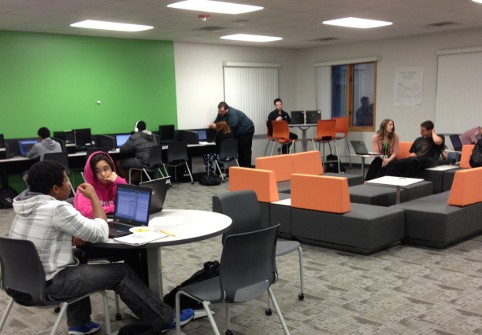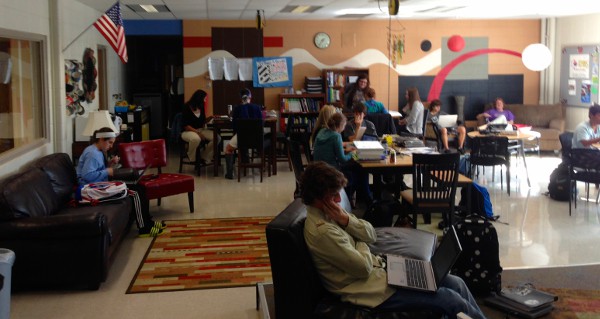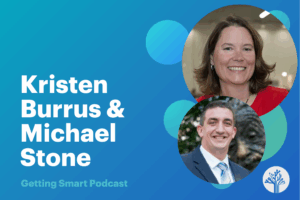12 Reasons Every District Should Open a Flex School

Flex model programs or schools have an online curriculum with onsite support. This category of blended learning is more common in high school because it requires a good deal of independent study. The Christensen Institute describes flex models this way:
Students move on an individually customized, fluid schedule among learning modalities. The teacher of record is on-site, and students learn mostly on the brick-and-mortar campus, except for any homework assignments. The teacher of record or other adults provide face-to-face support on a flexible and adaptive as-needed basis through activities such as small-group instruction, group projects, and individual tutoring.
Flex models vary in the degree and type of face-to-face support but many include small-group instruction, group projects, and individual tutoring. In contrast to rotation models where students spend 20-30% of their time online, students in flex models spend more than 50% of their time online. Matriculation at rotation schools is typically by cohort (with some flexibility to meet individual needs) while students in a flex models are typically progressing as they demonstrate mastery in most courses. Rotation schools add some online learning to what otherwise may look like a traditional school while flex schools start with online learning and add physical supports and connections where valuable expanding the potential for innovation is higher in flex schools.
Examples. The Flex name comes from San Francisco Flex and Silicon Valley Flex, two Bay Area schools that combine the K-12 core curriculum with a full day of academic support, clubs, and activities. FuelEd works with school districts to create flex learning environments with the PEAK platform which allows teachers to add open or created content.
The Carpe Diem network was launched with a top performing Yuma Arizona secondary school where students split their time between workshops and personal learning online. Six teachers and a team of paraprofessionals support the development of 300 students grades 6-12. Given the 50/50 split with online and workshops, some observers would call this an individual rotation model but the roots are pure flex (See feature on Carpe Diem Indianapolis and Cincinnati).
Connections Learning developed a midwest flex network of 7 Nexus Academies (above image). The double shifted high schools serve up to 300 students. The facilities look like modern office space. In addition to master teachers, students benefit from a counselor, a fitness trainer, and a success coach to guide them through Connections’ comprehensive online high school curriculum. Nexus students benefit from frequent small group instruction in half hour sessions.
In partnership with school districts, AdvancePath has been managing flex dropout prevention academies nationwide for most of a decade. Students that are a year or two behind have the opportunity to get back on track by earning credits more rapidly than would be possible in a typical classroom. AdvancePath has a robust response-to-intervention (RTI) solution for high school–a personalized pathway for every student.
After opening an iPrep demonstration site, Miami Dade added flex academies to 8 comprehensive high schools.
There are at least 12 potential benefits of flex models:
- Competency-based. Students progress based on demonstrated mastery. They use cohort groups and teams when and where they are helpful.
- Accelerated learning. Flex models allow students to move at their own pace. For students with partial content knowledge but credit deficiencies, the ability to move quickly and test out of topics they have mastered may allow them to earn credits at two or three times the normal rate.
- Customized experience. Flex models make it easy to customize the experience for each student. As platforms get more robust, student pathways will become more customized (by interest, modality, motivation, and schedule).
- Portable and flexible. Students can take a flex school on the road for a family vacation or for a work or community-based learning experience. There’s a flex school with a football team. For districts, flex programs can be quickly deployed in less than 90 days and scaled rapidly.
- Productive operations. Flex models have the potential to operate at lower cost than alternative education models.
- Small rural high schools. Flex models make it easy to run very good very small high schools. Where it would have been difficult to serve 100 students with a traditional comprehensive high school model, a flex program can offer every AP course, every foreign language, every high level STEM course–all in an affordable and well supported environment.
- New staffing models. Flex models make use of differentiated (levels) and distributed (locations) staffing. As noted at OpportunityCulture, we need to invent new ways to leverage talent with technology and flex models will be the source of the most interesting and productive staffing strategies.
- Early college. Flex models facilitate college credit accumulation in high school. Look for AP, dual enrollment, and career/major specific models. Flex students should be able to finish high school in three years with a year of college credit. Like Career Path High, a flex school can be located on a postsecondary campus.
- Career focus. Flex models can focus on particular careers and make time for work-based learning. GPS Education Partners is a network of manufacturing flex academies in the upper midwest where students take high school classes in the morning and complete manufacturing internships in the afternoon.
- Leverage local assets. Flex models have the unique ability to leverage community assets like museums, theaters, historical sites, natural resources, as well as local employers.
- Site visits. For many of us site visits are the most important component of professional learning. A flex academy provides a local opportunity for staff members to experience competency-based blended learning with innovative staffing and scheduling–a visit is far more powerful than reading about it.
- Early movers. Like two in-district charter high schools in Kettle-Moraine Wisconsin, flex schools can operate as a school-within-a-school offering thematic integration.

Do now. Using a flex model, every community can afford to have a great high school. Every community should have a flex option that provides a fully supported individualized pathway to graduation. Every community should use a flex model to leverage local resources and meet specific needs. Every district should open a flex model so that everyone can visit and experience the future of education.
For more on flex see:
- Connections Education Opens Blended High Schools
- Nexus Lansing: A New High School Experience
- Q&A with K12’s Darren Reed
- Q&A with AdvancePath president John Super
- Smart Cities: Miami on the Move
Tom is a director of AdvancePath. Connections and K12 are advocacy partners.







Kathleen Brenneman, School Pathways, LLC
We've seen this model grow quickly in California - a state that supports all forms of independent study. A stumbling block has been how to easily track what is happening in the brick-and-mortar classroom with online courses of study for evidence of daily engagement, course progress, and assessment of learning while also combining all information to present a report of competency and grades from a classroom point of view. We've worked hard at School Pathways to make tracking this type of education a reality in our student information system. As believers in personalizing education for all students, we're excited to see this growing model.
Annmaria De Mars
I attended a high school much like this in the 1970s. Graduated college at 19, MBA at 21 , later a PhD & founded a few companies. It worked great for me.